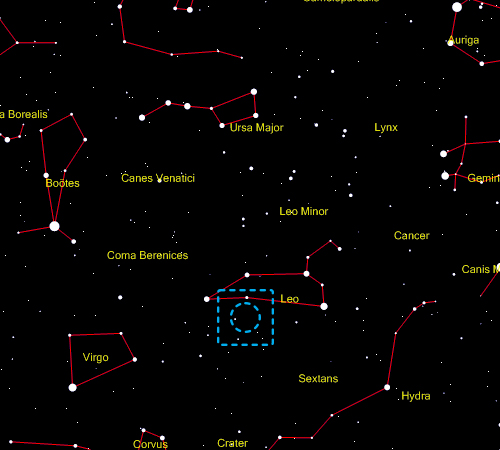The Leo Triplet is so named because it comprises three brilliant spiral galaxies, located approximately 35 million light years away, in the constellation of Leo. The group of galaxies is particularly interesting as astronomers now know that they are interacting with one another, although the interaction has affected M65 the least of the three.
Starting at the top of the image we find NGC 3628, the Hamburger Galaxy. It is considered the most difficult galaxy in the Leo Triplet to observe and went undetected by Charles Messier at the time that he found M66 and M65, only to be discovered and catalogued four years later by William Herschel. The Hamburger Galaxy is known for its distinctly wide dust band, which obscures its central region and the areas of star formation in its spiral arms, and its huge tidal tail, extending some 300,000 light years to the galaxy's left. The tidal tail is comprised mainly of recently formed open star clusters and starburst regions, believed to have been drawn out so significantly by violent encounters with the two other galaxies of the triplet. More evidence as to these encounters is the slightly warped shape of the Hamburger Galaxy’s disc.
Moving to the bottom right, we find M65, which was first discovered on March 1st, 1780, by Charles Messier, who, at the time, because of the great distance, recorded that it was a “faint nebula with no central star”. Now, with improved astronomical equipment, we can clearly see that M65 is indeed a spiral galaxy, although the date when that discovery was made is unclear. M65 is home to about 200 billion stars, although as it contains surprisingly little gas and dust, the ratio of older, mature stars to newly formed stars is quite high. However, Messier 65’s spiral arms do show evidence of recent star formation, which is, along with the slightly distorted shape of the galaxy's disc, an indication that M65 has been interacting with its two large, neighbouring galaxies.
At the bottom left of the image is M66, discovered by Messier on the same night as the considerably smaller M65. It is visible to the observer even with amateur binoculars, as a small ‘fuzzy patch of light’. Four supernovae have been recorded in M66 so far, as opposed to the smaller M65, which has only seen one. Messier 66 is also noteworthy for its prominent dark dust lanes and its many starburst regions along its outer spiral arms.
The ages of dominant stellar clusters in M65 and M66 are consistent, which suggests that the two galaxies have undergone synchronous evolution, meaning that the interaction between these two neighbours has likely triggered starbursts in both galaxies. This means that as the two galaxies have interfered with each other’s evolution, they have caused sudden, brief episodes of intense star formation - starbursts - to occur in unison.
The gravitational interaction between the Leo Triplet galaxies has significantly affected Messier 66. Approximately one billion years ago, an encounter between M66 and NGC 3628 resulted in many significant changes to M66’s structure, including its highly elevated central mass concentration and its asymmetrical spiral arms. One of these arms distinctly seems to pass over the left side of the galaxy’s central bulge, where signs of star formation are clearly visible, along with several nebulae of ionised hydrogen and a lot of interstellar dust. |


